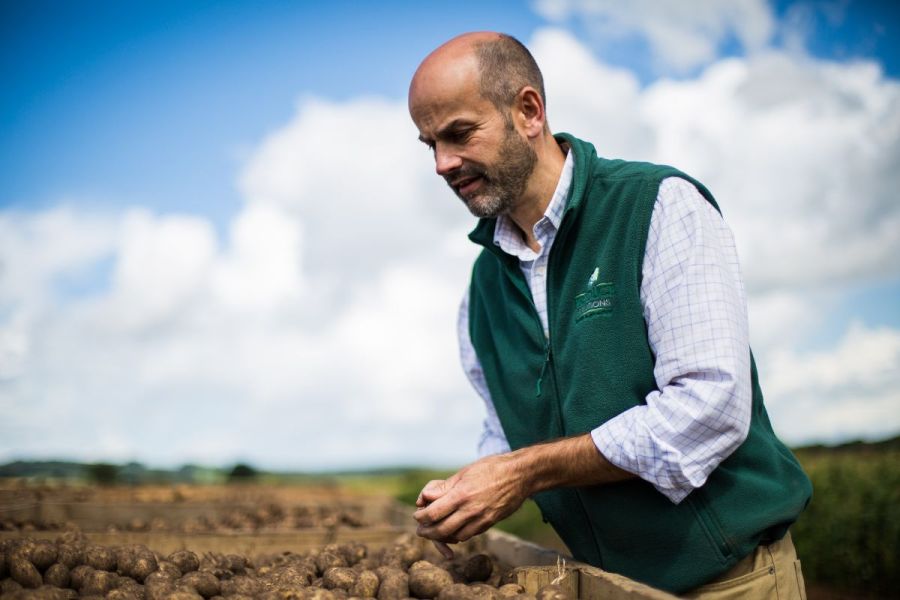Potato agronomy is complex and requires a lot of planning, monitoring and evaluation throughout the production process. CPM finds out how digital agronomy tool Crop4Sight can help in all three areas as preparation for the 2023 season gathers pace.
“If you don’t get things right on the day you plant, in almost all cases it won’t matter what you do for the rest of the season.”
By Lucy de la Pasture
‘If you fail to prepare, you prepare to fail’ – an adage that is very relevant when thinking about potato crop establishment, with half the agronomy done and dusted before a seed piece even drops into a ridge.
There are now tools that assist in this crucial planning process, including the dynamic seed module of Crop4Sight’s precision potato agronomy system, which takes the guesswork out of seed rate calculations for any given variety.
Getting seed rates right is one of the most important decisions a grower can make, and the nifty software can sort out all the details – tailoring seed rates to customer requirement, planting date and proposed burndown and harvest date. On top of that, it allows growers to model several scenarios to see how altering seed rate or planting date will affect yield and size distribution of the tubers in their ware crops.
Produce Solutions potato specialist Jamie Lee says it helps growers lay a solid foundation on which to build maximum marketable yield, whether for a pre-pack or processing crop.
“If you don’t get things right on the day you plant, in almost all cases it won’t matter what you do for the rest of the season, you won’t achieve what you should set out to achieve,” he explains.
Planting density – dictated by seed rate, or within row spacing – is key to hitting target yield and tuber size. It also reduces waste and ensures costly seed is used efficiently. Lower rates give established plants more space and generally result in fewer, larger tubers suitable for baking. Conversely, tighter spacing results in more, smaller tubers ideal for salad and seed crops.
It’s also possible to influence harvest date with seed rate, adds Jamie. “Lowering plant density can help tubers bulk faster for earlier lifting where it’s desired, either by the customer or sometimes the landlord.”
He advises that several factors have to be considered when calculating seed rates, including variety – as some produce more stems per plant and tubers per stem than others – planting date and seed size, determined by tuber count per 50kg of seed.
Historically, growers and agronomists would have worked out seed rates using experience and variety-specific seed rate tables based on data from breeders and AHDB-funded trials. The Crop4Sight seed module combines all these factors with data from independent variety trials and historic commercial data collected by the potato agronomy platform.
But it also takes things on a stage. Critically, it factors in the seed lot’s chronological age, which is the amount of time between emergence of the seed crop and planting of the ware crop.
Chronologically older seed produces more stems/plant, whereas chronologically younger seed tends to throw fewer stems/plant. This response is consistent across varieties, but some are more sensitive than others, he says.
The system also outputs a stem and tuber count prediction for the early part of the growing season to benchmark establishment success.
It’s a feature Jamie says has been particularly useful where cultivars are sensitive to chronological aging – like main crop variety Jelly – to help achieve the correct stem and tuber populations and to maximise marketable yield.
“The optimum tuber population for the contracted size specification and yield of a crop of Jelly is 350,000 tubers/ha and we know how many stems are needed to hit that target. Knowing the seed age means you have a better idea how many stems are likely to be produced from each seed tuber, which leads to a more accurate seed rate calculation.
“It avoids planting and then just hoping we get what we want at the end of the season, because quite often, with a lot of varieties, it won’t happen,” he explains.

John Weir explains he can now manage crops much better in the first instance, as well as use in-season data to evaluate crop management and fine tune it for the future.
One grower who has used the seed module to his advantage is John Weir, who grows 70ha of pre-pack potatoes at Gateside in Fife.
He’s been growing Cygnet PB’s variety Saxon on his light sandy soils for more than 20 years, so the business is well-versed in how to establish the second early to reach its full potential.
However, John recently started to grow two new varieties – early-maturing baker Tyson from STET and exclusive Greenvale Seed low input variety Soraya – so had little knowledge of how they might behave in the field.
As the platform draws on data from independent variety trials, which investigate stem numbers and tubers per stem across a variety of planting dates and seed sizes, it can make an informed seed rate recommendations for new varieties.
For John, access to the module meant he was able to hit the ground running. As the crop modelling functionality of the main Crop4Sight programme collects data on field performance, he’ll also build up a databank to inform management of future crops.
“In the past, you might have an indication on what to do with new varieties from the seed house, but you didn’t really know if you’d got things right until the end of the season.
“We can now manage crops much better in the first instance, then with plant counts, stem counts and tuber counts, and by monitoring canopy development through the season, we can evaluate what we’ve done and fine tune our management in the future,” explains John.
His Produce Solutions agronomist, Nathan Edgar, adds that in a tricky spring, like the season before last when planting was delayed, a simple change to planting date in the “live” system will automatically adjust seed rate accordingly.
The system’s output has given the pair confidence to reduce the farm’s seed rates more than they would have done in the past, which has cut seed costs in some varieties and ensured that target harvest dates have been met.
Nathan adds that Crop4Sight data is consistently challenging their decision making and driving discussion during the season and while planning for the next.
“First and foremost, it’s a tool for the grower to better manage their crops and increase marketable yield. But its full potential is extracted when the grower, agronomist and Crop4Sight all work together,” he says.
Processing grower benefits from in-season data insights

John Bubb says inputting field data into Crop4Sight informs scheduling of key tasks, such as maleic hydrazide applications and timing burndown when the crop is at optimum yield.
Crop4Sight’s seed module and in-season crop development insights are helping John Bubb hit his target of getting all of his 200ha of processing potatoes out of the ground by 20 October.
Near Newport in Shropshire, he grows for McCain, supplying Shepody and Morene off the field early, with the remainder – Royal, Maris Piper and King Russet – out of bulk storage from February to June.
Pre-season planning is critical for the business and alongside his agronomist Jamie Lee, he has used the seed module to calculate the appropriate seed rates to hit his contract specifications.
This commences when seed arrives on the farm in January, with the seed supplier often providing information on seed age. Then Jamie gathers tuber counts and uses the digital tool to make seed rate recommendations for each lot.
The information in the seed module, including seed age and predictions on plant and stem counts, will give an early indication of which crops will be further forward later in the season. This is critical for both grower and McCain, as they can plan when the crop will be harvested and moved, he says.
For John, one of the most interesting parts of using Crop4Sight is at emergence, when it’s time to ground truth the plant and stem count predictions. He notes that prediction versus reality has been close in most instances.
Once the data has been gathered and entered into Crop4Sight, the tool produces a yield forecast, predicts tuber population, and forecasts final marketable yield and size distribution.
John is also using satellite imagery uploaded to the platform to monitor canopy development, enabling him to pick up any issues early if the actual canopy starts to fall behind the prediction.
The forecasts quickly show which crops have smaller tuber numbers, so will develop faster, and might be harvested earlier, he adds. Other crops may have more tubers and yield potential, so will need growing on and require more nitrogen to get there, so nutrition programmes can be adjusted.
John says that data from mid-season yield digs to check crop progress informs scheduling of key tasks, such as maleic hydrazide applications and timing burndown when the crop is at optimum yield.
“Crop4Sight’s prediction of tuber initiation has also been useful, as we get an idea of when we need to start irrigating.
“We’ve also invested in the system’s irrigation module, which is a live cloud-based scheduling tool that’s easy to use and can be accessed by anybody at any time of day or night.
“We enter our local weather and irrigation data throughout the season and it will tell us the soil moisture deficit and when irrigation is required. The previous system relied on another data source and was far less flexible,” says John.
This article was taken from the latest issue of CPM. For more articles like this, subscribe here.




